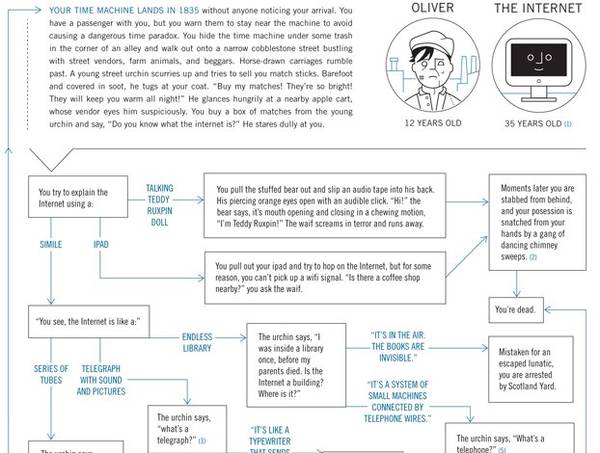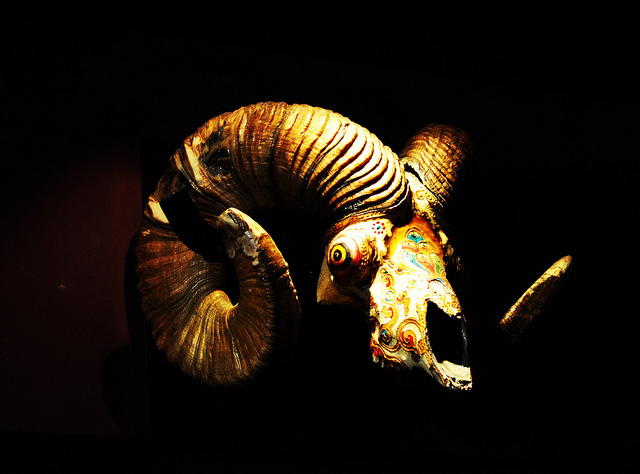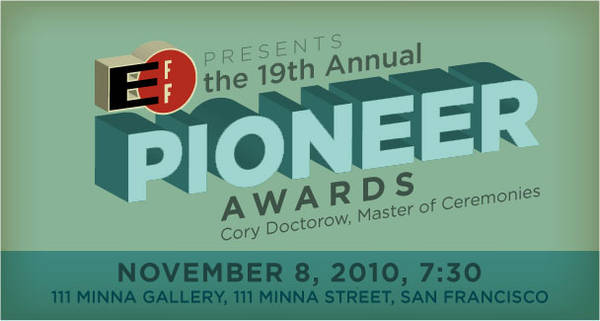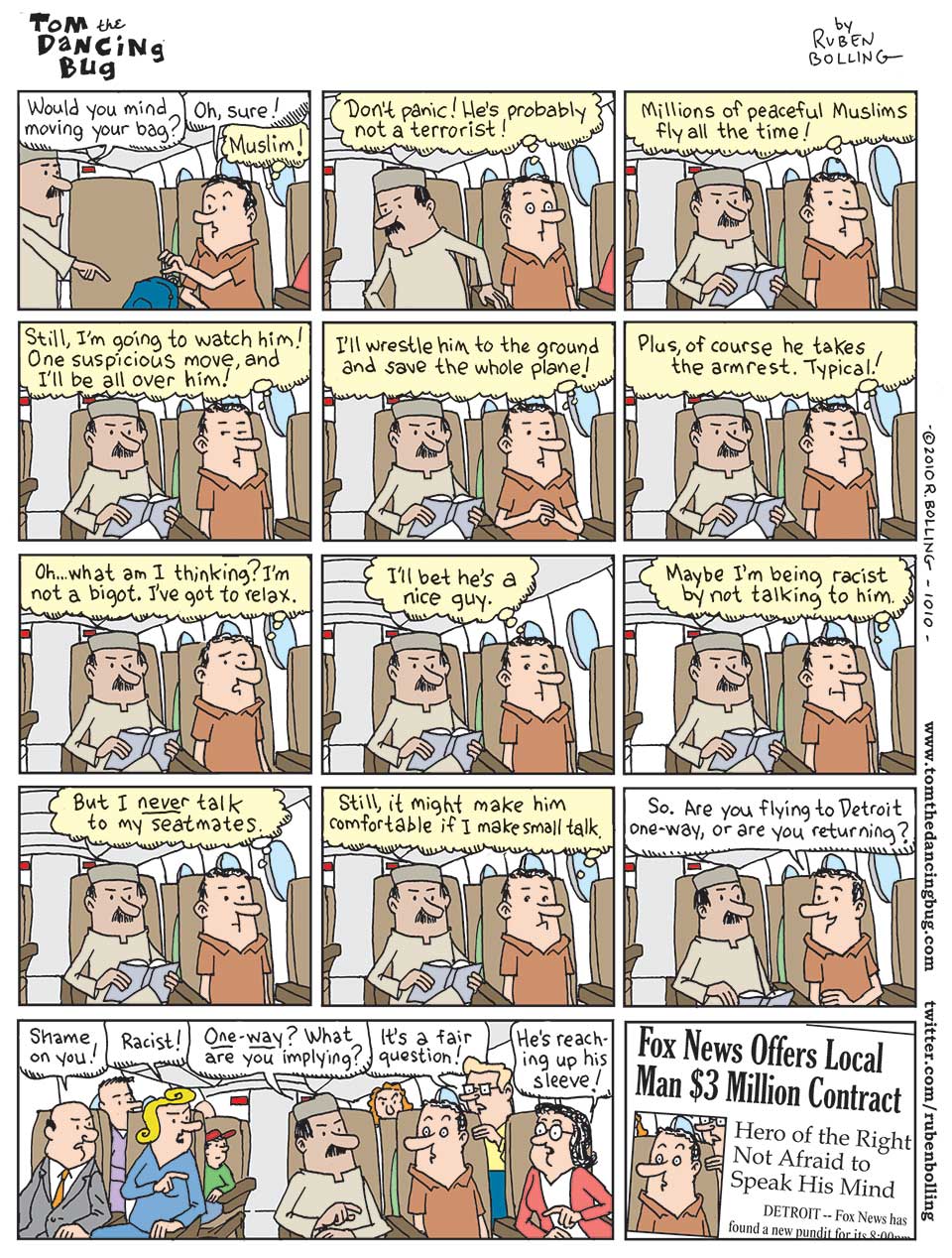The Latest from Boing Boing |  |
- Emergency Unicorn Delivery
- HOWTO explain the Internet to a Dickenian street urchin
- What should Dyster do with this late 19th century folio of lithos?
- Photos from Toronto's crane-climbing urban explorer
- Disturbing, delightful and very, very short: Fiction in 25 words or fewer
- Cholera and the environment
- Science explains what happens when one handles a cobra "in a less than sensible manner"
- Knipex Pliers Wrenches
- Homemade Hobbit Feet for Hallowe'en
- In sting, Feds instruct alleged would-be terrorist to conduct video surveillance of D.C. Metro
- 30 Congolese women imprisoned in "dungeon," systematically raped
- New "snub-nosed" monkey species discovered, killed, eaten
- Open thread: your DIY Hallowe'en costumes?
- Fictional Star Wars artifact: Boba Fett's invoice to Jabba the Hutt
- $107 Sears catalog home, 1908 (assembly required)
- Christine O'Donnell's campaign manager offers $1,000 to anyone who can prove "separation of church & state" is in the Constitution
- Tom the Dancing Bug: Muslim on a Plane
- Stomper wants apology from victim
- Liar, Liar, Sheep on Fire
- EFF Pioneer Awards in San Francisco, Nov 8
- Sterling's Gold
- Twenty-First Century Stoic -- From Zen to Zeno: How I Became a Stoic
| Posted: 27 Oct 2010 10:56 PM PDT |
| HOWTO explain the Internet to a Dickenian street urchin Posted: 27 Oct 2010 10:37 PM PDT  From Fast Company's ongoing "Explaining Everything With Flowcharts" series, a flowchart showing how a time-traveller could explain the Internet to a Dickensian street-urchin. Very funny stuff and excellent use of a maze! Flowchart: Understanding the Web, for Fans of Charles Dickens (via MeFi) |
| What should Dyster do with this late 19th century folio of lithos? Posted: 27 Oct 2010 10:36 PM PDT  Dyster sez, "I recently bought an extremely rare old folio of lithographs, drawn by Hans J. Jedlitschka, sometime, it is guessed, between 1895 and 1910. I've put up a flickr set of med/hi res shots, linked above, and I'd be interested to hear people's ideas about how best to share these beautiful prints with interested parties. Better photos? Vectorized files? A book? Who knows a thing or two about copyright issues with something like this?" I think you're safe on the copyright front, Dyster, but I'd love to hear what you folks think should be done with these! |
| Photos from Toronto's crane-climbing urban explorer Posted: 27 Oct 2010 10:36 PM PDT  David Topping from Torontoist sez, "Torontoist has an interview with HI-LITE, an urban explorer who favours cranesâ€"and whose shots of Toronto from dozens of storeys off the ground are totally amazing." I left Toronto in 1999 after 29 years in the city; every time I go back there's a whole new forest of high-rises (usually filled with badly made, tiny condos) on display. As it is on the high seas, perched on a tower crane, wind is a constant. The entire crane actually sways to and fro. Winter or summer, the air is always chilled. Replacing the scent of salted sea air is the smell of the industrial lubricants used to maintain the crane's slewing unit.View From The Crow's Nest (Thanks, David!) |
| Disturbing, delightful and very, very short: Fiction in 25 words or fewer Posted: 27 Oct 2010 07:54 PM PDT  I love these snippets from Hint Fiction: An Anthology of Stories in 25 Words or Fewer, that were published in the New Yorker. An anthology, edited by Robert Swartwood, it includes an eerie piece by my friend and fellow Minneapolitan Jeremy Zoss, called "Houston, We Have a Problem":
Perfect reading for those winter evenings where you just want to take in a sentence, and then stare out the window for 20 minutes digesting it. Image of something else disturbing and short: Some rights reserved by Alyssa L. Miller |
| Posted: 27 Oct 2010 07:37 PM PDT Cholera is a disease of poverty. But it's also a disease that prefers warmer water, high salinity, and algae blooms for ideal growth conditions. This fascinating NPR story talks about cholera's connection to the environment. In some parts of the world, it's even demonstrated a seasonal pattern. Does that mean cholera is also a disease of climate change? Maybe. But also maybe not. There are a lot of unknowns, a lot of potential factors involved in the spread of cholera, and scientists are only starting to tease all those threads apart. |
| Science explains what happens when one handles a cobra "in a less than sensible manner" Posted: 27 Oct 2010 07:24 PM PDT  Sometimes, fascinating research hides behind eyes-crossingly boring paper titles. Other times, well, that's not the case ... as blogger Emily Anthes found, when she stumbled across an article in the journal Anaesthesia and Intensive Care titled, straightforwardly, "Joseph Clover and the cobra: a tale of snake envenomation and attempted resuscitation with bellows in London, 1852." If that's not enough to get your attention, try the abstract:
Be entertained and learn a very valuable lesson about snake handling at Anthes' Wonderland blog. Image: Some rights reserved by Enygmatic-Halycon |
| Posted: 27 Oct 2010 02:37 PM PDT  The Knipex Pliers Wrench is best described in the US as a smooth-faced channel lock plier/wrench. Or, as a pliers-handled crescent wrench. I have a set of 3 different sizes and have used them for a year. They allow one to rapidly, safely and strongly grip nuts or bolt heads for tightening or loosening. Rapidly: an adjustable crescent wrench is not rapid. One must adjust the opening to the nut or bolt head, and between tightening turns, in removing and replacing the wrench, inevitably the wrench loosens a bit and must be retightened. An open-ended or box wrench or socket is the best tool to use, but then one must keep in hand a range of sizes for each size of nut/head. In contrast the Knipex pliers wrench loosens and tightens like a pair of pliers or channel lock wrench. Safely: an adjustable crescent wrench tends to loosen, rounding off the corners of the nut or bolt head. Pliers or vice-grips are worse, putting teeth-marks on the nut or head. In contrast the Knipex pliers wrench has flat, smooth, and parallel heads ensuring no rounding or gouging of the nut/head. Strongly: the lever arm of the Knipex ensures a strong grip on the nut/head. I've used them to squeeze small solid aluminum rivets in building an experimental airplane. To summarize, the Knipex pliers wrench combines the best features of other tools, enabling one to grip and turn nuts and bolts with a single tool, and apply considerable squeezing pressure on objects without gouging or tooth marks. -- Ralph Fincher Knipex 10-Inch Pliers Wrench $48 Available from Amazon Comment on this at Cool Tools. Or, submit a tool! The Knipex Pliers Wrench is best described in the US as a smooth-faced channel lock plier/wrench. Or, as a pliers-handled crescent wrench. I have a set of 3 different sizes and have used them for a year. They allow one to rapidly, safely and strongly grip nuts or bolt heads for tightening or loosening. Rapidly: an adjustable crescent wrench is not rapid. One must adjust the opening to the nut or bolt head, and between tightening turns, in removing and replacing the wrench, inevitably the wrench loosens a bit and must be retightened. An open-ended or box wrench or socket is the best tool to use, but then one must keep in hand a range of sizes for each size of nut/head. In contrast the Knipex pliers wrench loosens and tightens like a pair of pliers or channel lock wrench. Safely: an adjustable crescent wrench tends to loosen, rounding off the corners of the nut or bolt head. Pliers or vice-grips are worse, putting teeth-marks on the nut or head. In contrast the Knipex pliers wrench has flat, smooth, and parallel heads ensuring no rounding or gouging of the nut/head. Strongly: the lever arm of the Knipex ensures a strong grip on the nut/head. I've used them to squeeze small solid aluminum rivets in building an experimental airplane. To summarize, the Knipex pliers wrench combines the best features of other tools, enabling one to grip and turn nuts and bolts with a single tool, and apply considerable squeezing pressure on objects without gouging or tooth marks. -- Ralph Fincher Knipex 10-Inch Pliers Wrench $48 Available from Amazon Comment on this at Cool Tools. Or, submit a tool! |
| Homemade Hobbit Feet for Hallowe'en Posted: 27 Oct 2010 02:31 PM PDT  In an epic-and-still-growing Boing Boing thread about homemade costumes (and mutant costume ideas), BB reader Nanner shares the story of how she crafted Hobbit Sneakers for her 9-year-old, who is going as Frodo. "I also made his cloak but haven't taken pix of the whole costume yet," she adds. More pix here. |
| In sting, Feds instruct alleged would-be terrorist to conduct video surveillance of D.C. Metro Posted: 27 Oct 2010 02:21 PM PDT Snip from Washington Post: "Ahmed began to meet in hotels in Northern Virginia with people he believed to be affiliated with a terrorist organization. He agreed to conduct video surveillance of the [Washington Metro] stations, suggested the best time to attack and the best place to place explosives to maximize casualties, the [federal] indictment alleges." Via the BB Submitterator, EvilMike asks, "Could this be something used as a future reason to restrict photography and videos of government property?" |
| 30 Congolese women imprisoned in "dungeon," systematically raped Posted: 27 Oct 2010 05:55 PM PDT Thirty Congolese women were held in a "dungeon" on the border of Congo and Angola and systematically raped by uniformed men over a period of weeks earlier this month, say U.N. officials. They were part of a group of 150 expelled from Angola, 3 of whom were killed (one, a woman who died from the physical trauma of repeated rape). Survivors were released on the Congolese side of the border, naked and with no belongings. |
| New "snub-nosed" monkey species discovered, killed, eaten Posted: 27 Oct 2010 01:03 PM PDT  Photograph: Ngwe Lwin via National Geographic. Killed for food, an R. strykeri monkey is displayed in Myanmar in early 2010. The only scientifically observed specimen of a newly discovered monkey species in Myanmar (Burma) was killed by local hunters by the time researchers found it. Shortly thereafter, it was eaten. This species of monkey in fact so snub-nosed that it is said to sneeze uncontrollably when it rains. But "Snubby" has far greater problems than the sniffles. Local demand for monkey flesh as a food source is one of many reasons the species is endangered; habitat destruction by Chinese logging companies is a big threat, which in turn leads to more hunting: no forest means fewer barriers to tracking and killing these beautiful, vulnerable beasts. Read more here at National Geographic News. (via Submitterator, thanks, Ted and Marilyn Terrell) |
| Open thread: your DIY Hallowe'en costumes? Posted: 27 Oct 2010 12:24 PM PDT  Image: Underwater witch at Halloween, Rainbow Springs, FL, mid-1950s. Via Flickr Commons, from Florida State Archives. I'm thinking of going as "Sexy SQL Database," or maybe stringing a bunch of hard drives and shredded FOIA documents on a blood-red ballgown and going as Wikileaks. How 'bout you? Your ideas for the BoingBoing-iest homemade costumes welcomed in the comments. |
| Fictional Star Wars artifact: Boba Fett's invoice to Jabba the Hutt Posted: 27 Oct 2010 11:52 AM PDT  [Flickr page here, and large size here.] Via the BB Submitterator, reader Dan says, "Brock Davis is an artist for Wired, the New York Times, and other outlets, but here he created a funny Star Wars artifact. My favorite bit is that the invoice echoes period paperwork from the late '70s-early '80s when the Star Wars movies were released." |
| $107 Sears catalog home, 1908 (assembly required) Posted: 27 Oct 2010 11:15 AM PDT  Image: Click to embiggen. 1908 Sears mail-order house No. 115 for $725. I used to write ads for Sears, and I always admired their influence in American DIY/maker culture. They had a huge influence on reducing local general stores' price-gouging practices, and they gave consumers access to goods that were hard to come by (they started when there were no cars and only 38 US states). Back when Sears, Roebuck & Co. and Montgomery Ward were battling it out over who would be the analog version of Amazon, Sears offered increasingly ambitious and specialized catalogs. One of their most ambitious projects was mail-order homes, inspired by success of The Aladdin Company. Last year, Cory blogged about Thomas Edison's similar prefab concrete home venture. But Sears Modern Homes had huge success with their wood-framed homes from 1908 through the Great Depression. Their cheapest model was $107 in 1908 (about $2,000 today). Unlike a lot of modern prefab, these were made to last; you can still find these homes here and there around the country. |
| Posted: 27 Oct 2010 10:25 AM PDT Jonathan Moseley, a Virginia attorney serving as Christine O'Donnell's campaign manager during the primary, offers a "$1,000 reward to anyone who can find the phrase 'Separation of Church & State' in the US Constitution." (via Teresa Nielsen Hayden) |
| Tom the Dancing Bug: Muslim on a Plane Posted: 27 Oct 2010 09:28 AM PDT |
| Stomper wants apology from victim Posted: 27 Oct 2010 09:06 AM PDT The Rand Paul staffer involved in a recent incident has asked for an apology from the woman who brutally headbutted his foot. [TPM] |
| Posted: 27 Oct 2010 09:12 AM PDT  Photo: Prasad Kholkute Firesheep should freak you out, at least for a moment. It's a Firefox extension that lets any normal human being--I'm not talking about you, BoingBoing readers--install the add-on and then steal the active sessions of people using unencrypted browsing sessions with popular online services on the same Wi-Fi network. This involves no Wi-Fi foolery, because the necessary network traffic is openly available. Walk into any busy coffeeshop, fire up the 'sheep, and a list of potential identities to assume at any of two dozen popular sites appears. Double-click, and you snarf their identifying token, and log in to the site in question as that person. Firesheep is a business-model tour de force, not a zero-day technical one. It's a proof of concept that repackages and expands on earlier security research to expose a failure in the risk profile adopted by Web sites on behalf of their unsuspecting users. There's no money to be made by a Web site in fixing this problem for its customers or readers. Thus, only a security-conscious CIO might be able to push through the budget item necessary to bump the back-end systems up to the level needed. Firesheep is a public relations exploit, too; it's so easy to use and to demonstrate that it shot round the world. Previous demonstrations spread the word in the tech community, and a little beyond. Firesheep is telegenic. Photo: Prasad Kholkute Firesheep should freak you out, at least for a moment. It's a Firefox extension that lets any normal human being--I'm not talking about you, BoingBoing readers--install the add-on and then steal the active sessions of people using unencrypted browsing sessions with popular online services on the same Wi-Fi network. This involves no Wi-Fi foolery, because the necessary network traffic is openly available. Walk into any busy coffeeshop, fire up the 'sheep, and a list of potential identities to assume at any of two dozen popular sites appears. Double-click, and you snarf their identifying token, and log in to the site in question as that person. Firesheep is a business-model tour de force, not a zero-day technical one. It's a proof of concept that repackages and expands on earlier security research to expose a failure in the risk profile adopted by Web sites on behalf of their unsuspecting users. There's no money to be made by a Web site in fixing this problem for its customers or readers. Thus, only a security-conscious CIO might be able to push through the budget item necessary to bump the back-end systems up to the level needed. Firesheep is a public relations exploit, too; it's so easy to use and to demonstrate that it shot round the world. Previous demonstrations spread the word in the tech community, and a little beyond. Firesheep is telegenic. The add-on is the latest effort to lay bare a well-known problem in how major (and minor) Web sites identify users after login. Even if you log in using a secure SSL/TLS connection, a reliable method of end-to-end encryption, many sites still hand you back to plain old HTTP. In the process, sites brand you with a token that stands in for the login process you completed. This is a separate issue from involuntary ad tracking or the undeletable evercookie. (BoingBoing is a practitioner of tokens for both commenting and the Submitterator, which arguably means that someone could post nonsense under your name from a coffeeshop, but don't do that already?) Because the open Web is stateless, a sequence of pages viewed by the same browser might as well be pages viewed by entirely different browsers. A login token placed in a cookie glues a binding on the edge of those pages, creating a session. The token doesn't let a third party sniff your user name or password, but it does let a browser lay claim to your identity for a set period of time. (HTTP does have a stateful account-based authentication system, but it has weak cryptographic elements, and browsers have unchangeable interface elements for handling failed logins, lost passwords, or add-ons, like a CAPTCHA.) The developer of Firesheep, Eric Butler, traces the understanding back to 2004, but 2007 is when knowledge went over the top. Robert Graham of Errata Security coined the term in 2007 in a Black Hat presentation. He created a proof-of-concept not much different in intent or function than Firesheep, but without the click-to-install simplicity, the long list of sites to snarf, and browser integration. Of the large firms with this flaw, I'd argue that Google took this most seriously. In the intervening three years, Google has been layering SSL/TLS on ever more of its services. Gmail even added an option to kill other sessions. (Scroll to the bottom of the Gmail screen, and click Details at the end of the "last account activity" line to view the option.) Many other sites have let the problem remain, though, beefing up security through the sop of offering secure logins, as noted above. It's quite rare to find any major site allowing an unencrypted login, which is a big improvement over a few years ago. Firesheep comes with 26 prefabricated sidejacking tools for sites like Facebook, Amazon, and bit.ly. Amazon and other sites that have a mix of plain HTTP and SSL/TLS-protected pages require re-authentication and SSL/TLS when you move into making a purchase, canceling an order, or other account-based activities. But you can place a 1-Click order without logging in again. Less-visited sites in the millions have this sheepish problem, and some use identical software (and thus token names in the browser) making a mass-exploit via a Firesheep update the work of minutes. But it's far less likely a random coffeeshop ne'er-do-well would sidejack such a session, or get anything out of it. The remaining question is, of course, what can you do to prevent your credentials from making you go baaaaaaaaaa? Lots. * Firefox users should install HTTPS Everywhere, a joint effort of The Tor Project and the Electronic Frontier Foundation. This forces SSL/TLS connections for sites that offer, but don't require, continuous secured browsing, including content sites like the New York Times and Wikipedia. You can use the Tools > Add-Ons option to disable specific sites if you have trouble. * Engage in no unsecured Web logins when working on an untrusted network, public or otherwise. This is my primary approach after HTTPS Everywhere. It's easier than it sounds. If I can't use SSL/TLS through a session, I don't do it unless I use a VPN (see below). * Secure all the services you use. Most email hosts offers SSL/TLS protected POP, IMAP, and SMTP sessions. FTP is absolutely in the clear; use SFTP (an SSH-based variant) or FTPS (FTP with SSL/TLS encryption). Check the box for SSL/TLS anywhere it's available. Twitter's API for third-party clients defaults to unprotected transactions; Echofon, at least, has a "use SSL" box I check. * Use a VPN. A virtual private network connection creates an encrypted tunnel for all your data between your computer or mobile and a server somewhere else on the Internet. That's typically more than enough to protect you from sniffing on the local link. I've used WiTopia for years, which is a fee-based service offering PPTP and SSL VPN connections. AnchorFree offers Hotspot Shield at no cost. * Instead of a VPN, set up an SSL/TLS Web proxy through which all your browsing is rerouted. That also protects the local link, and can be easier if you have a server elsewhere that you can set this up, or use a paid service. Eric Butler has complementary advice in a post on his site about the day after releasing Firesheep that he wrote with co-presenter Ian Gallgher. Read that for more on what does not work, too. Firesheep is named after the famous Wall of Sheep at Defcon, which displays selected details of unencrypted logins and other sessions over the event's Wi-Fi network from people who, by attending Defcon, should know better than to ever send anything unencrypted over a public Wi-Fi network. If Firesheep succeeds, the whole world becomes a Wall of Shame, with the shame reflecting on the sites that haven't updated their costs and systems to reflect the current reality of basic security when their users surf in public. Glenn Fleishman contributes continuously to the Economist's Babbage blog, and is a senior editor at the Mac journal TidBITS. |
| EFF Pioneer Awards in San Francisco, Nov 8 Posted: 26 Oct 2010 10:52 PM PDT  I'm coming to San Francisco next month to present the 19th Annual Electronic Frontier Foundation Pioneer Awards (this year's winners are Stephen Aftergood, James Boyle, Pamela Jones and Groklaw, and Hari Krishna Prasad Vemuru -- see here for full announcement). The event's taking place at the 111 Minna Gallery at 7:30 PM, and is preceded by a "VIP event" with the Pioneer Award winners, EFF founders and board members at 6:30 (separate ticket). Funds raised from tickets go to support the EFF's amazing work (as a former employee, I can attest to how far they stretch your dollars), needed now more than ever in this era of increased pressure to surveil, control and censor the Internet. My appearance at the Pioneer Awards is part of a longer trip that includes three days in Cedar Rapids, Iowa as guest of honor at ICON 35: A Steam Powered Convention of the Future -- they're footing the bill to get me from London to the USA. I'll be doing a post on ICON later, but I wanted to mention them here -- without their support, I couldn't do the EFF event. |
| Posted: 27 Oct 2010 08:19 AM PDT  "Sterling's Gold," the autobiography of mid-century advertising great Roger Sterling, is to be reissued by Grove Press after being out of print for 45 years. Sterling's Gold: Wit and Wisdom of an Ad Man "Sterling's Gold," the autobiography of mid-century advertising great Roger Sterling, is to be reissued by Grove Press after being out of print for 45 years. Sterling's Gold: Wit and Wisdom of an Ad Man |
| Twenty-First Century Stoic -- From Zen to Zeno: How I Became a Stoic Posted: 26 Oct 2010 10:06 PM PDT  I never intended to become a Stoic. Who, after all, were the Stoics? They were those grim, wooden figures of ancient Greece and Rome whose goal it was to stand mutely and take whatever the world could throw at them. Right? I never intended to become a Stoic. Who, after all, were the Stoics? They were those grim, wooden figures of ancient Greece and Rome whose goal it was to stand mutely and take whatever the world could throw at them. Right? About a decade ago, though, I began a research project on human desire. The goal of the project was to write a book on the subject, but I also had a hidden agenda in conducting my research: I was contemplating becoming a Zen Buddhist and wanted to learn more about it before taking the leap. But the more I learned about Zen, the less it attracted me. Practicing Zen would require me to suppress my analytical abilities, something I found it quite difficult to do. Another off-putting aspect of Zen was that the moment of enlightenment it dangled before its practitioners was by no means guaranteed. Practice Zen for decades and you might achieve enlightenment -- or you might not. It would be tragic, I thought, to spend the remaining decades of my life pursuing a moment of enlightenment that never came. Zen doubtless works for some people, but for me, the fit wasn't good. Then something quite unexpected happened. As part of my research, I investigated what ancient philosophers had to say about desire. Among them were the Stoic philosophers -- people like Marcus Aurelius, Seneca, and Epictetus -- about whom I knew little. As I read them, I discovered that they were quite unlike I imagined they would be. Indeed, it soon became apparent that everything I "knew" about the Stoics was wrong. They were neither grim nor wooden. If anything, the adjective that I thought described them best was "buoyant" or maybe even "cheerful." And without consciously intending to do so, I found myself experimenting with Stoic strategies for daily living. Thus, when I found myself in a predicament -- being stuck in traffic, for example -- I followed the advice of Epictetus and asked myself what aspects of the situation I could and couldn't control. I couldn't control what the other cars did, so it was pointless -- was in fact counterproductive -- for me to get angry at them. My energy was much better spent focusing on things I could control, with the most important being how I responded to the situation. In particular, I could employ Stoic strategies to prevent the incident from spoiling my day. I also started making use of the Stoic technique known as negative visualization: I would periodically contemplate the loss of the things and people that mean the most to me. Thus, when parting from a friend, I might make a mental note that this could conceivably be the last time I would see the friend in question. Friendships do end, after all, and people die suddenly. Doing this sort of thing may seem morbid, but the practice of negative visualization is a powerful antidote to a phenomenon that will otherwise deprive us of much of the happiness we could be enjoying: negative visualization prevents us from taking for granted the world around us and the people in it. When they hear about negative visualization, people often get the wrong idea. They think the Stoics advocate that we spend our days dwelling on all the bad things that can happen to us. This, of course, would be a recipe for a miserable existence. What the Stoics in fact advocate is not that we dwell on bad things but that we contemplate them, a subtle but important difference. They also recommend that we engage in negative visualization not constantly but only a few times each day and for only a few seconds each time. Our negative visualizations, then, will take the form of fleeting thoughts. Visualizing in this manner has the effect of resetting the baseline against which we measure our happiness, and it can have a profound and immediate effect on that happiness. As the result of negatively visualizing, we might find ourselves taking delight that we still possess the things that only moments before, we took for granted, including our job, our spouse, our health -- indeed, our very existence. One of my favorite visualization exercises involves the sky. When I see it, I periodically remind myself that the sky didn't have to be blue. But on most days it is blue, and a gorgeous blue, the hue of which changes subtly from hour to hour. Then I reflect on how wonderful it is that we inhabit a universe that can, on a nearly daily basis, present us with such a spectacle. A simple exercise, to be sure, and some would say a silly one. But if you can learn to appreciate the sky -- something most people take utterly for granted -- there is a good chance that you can learn to appreciate your life as well and thereby enjoy a happier existence than would otherwise be the case. I mentioned above that the benefits to be derived from practicing Zen are uncertain. Stoicism, by way of contrast, does not dangle before its adherents a moment -- maybe -- of life-transforming enlightenment. Instead, it provides a body of advice for them to follow and a set of strategies for them to employ in everyday life. The strategies in question are easy to use. (Indeed, I suspect that many of the readers of this essay have already, in the last few seconds, successfully attempted negative visualization.) That said, I should add that it takes rather longer to internalize Stoic advice and strategies so that one's response to the events of daily living becomes reflexively Stoical, at which point one can truly claim to be a Stoic. My experiments with Stoicism were sufficiently encouraging that I abandoned my plans to become a Zen Buddhist and decided instead to follow in the footsteps of Zeno of Citium, the Greek who formulated Stoicism in about 300 B.C. I decided, in other words, to become a walking, talking anachronism: I would attempt to transform myself into a twenty-first century Stoic. My goal in the essays in this series is to describe some aspects of this transformation. Most people, of course, would think of Zen Buddhism and Stoicism as being polar opposites, philosophically speaking, but that is because people tend to be, as I was, woefully ignorant of what Stoicism is. One of the most surprising things that came out of my research was how much Zen and Stoicism have in common. They both advocate taking what Buddha referred to as "the middle path." Buddha lived a life of luxury in a palace but was not fulfilled by that life. He abandoned the palace to live a life of extreme asceticism but again did not find fulfillment. It was then that he experienced his moment of enlightenment. The wise person, Buddha concluded, will not shun pleasure; at the same time, he will keep firmly in mind how easy it is to become enslaved by it. He will therefore be guarded in his enjoyment of pleasure. The Stoics likewise advocated taking the middle path. Zeno of Citium began his philosophical education by practicing Cynicism, the ancient philosophy that advocated an ascetic lifestyle. The ancient Cynics (including Diogenes of Sinope and Zeno's teacher Crates) lived on the street and owned only the clothing that they wore. Zeno abandoned Cynicism in part because he rejected its asceticism. In the Stoic philosophy he formulated, we are told that there is nothing wrong with enjoying life's pleasures, as long as we are careful not to allow ourselves to be enslaved by them and as long as, even while we are enjoying them, we take steps to prepare ourselves ultimately to be deprived of them. Offer a Stoic a glass of fine champagne, and he probably won't refuse it; as he drinks it, though, he might reflect on the possibility that this will be the last time he drinks champagne, a reflection, by the way, that will dramatically enhance his enjoyment of the moment. Then again, offer a Stoic a glass of water, and he might go through the same thought processes with the same result. In having "last time" thoughts (which, by the way, are a form of negative visualization), a Stoic is behaving rather like a Buddhist. Both Stoics and Buddhists think it important, if we are to have a good life, that we recognize the transient nature of human existence, and both advise us periodically to contemplate impermanence. This is what Stoics are doing when they reflect on the fact that since we are mortal, there will be a last time for each of the things we do in life. Thus, there will be a last time you drink champagne -- or water, for that matter. There will be a last time you touch the face of another human being. There will even be a last time you utter the word "forever." Along similar lines, both Zen Buddhists and Stoics think it important for us to strive to stay "in the moment." People tend to spend their days and consequently their lives as well dwelling on things that happened in past moments and worrying about things that will happen in future moments. As a result, there is little time left for them to savor the moment they currently are living. If we are to have a good life, it is important, says Stoic Marcus Aurelius, for us to keep in mind that "man lives only in the present, in this fleeting instant." For one last parallel between Buddhism and Stoicism, consider again the above-described blue-sky exercise. As a Stoic, I had practiced this exercise for years before I became aware of the work of Buddhist monk Thich Nhat Hanh. It turns out that Buddhists, in their practice of mindfulness, employ a similar exercise: see this video. On adopting Stoicism, I discovered how much the world has changed since the philosophy was first formulated. Back then, if you told someone you were a practicing Stoic, they would have understood what you meant. In ancient Greece and Rome, it was common for people in the upper classes to adopt a philosophy of life; indeed, parents sent their sons to schools of philosophy (prominent among which were the Stoic, the Epicurean, and the Academic schools) in part to acquire such a philosophy. Tell modern individuals that you are a practicing Stoic, though, and they are likely to be puzzled. "Is it some kind of religion?" they will ask. My standard response: "No. Religions generally concern themselves with the afterlife; philosophies of life such as Stoicism concern themselves with daily life. They teach us what things in life are most valuable and how best to attain them." This response is likely to give rise to a new question: "And just what did the Stoics think was valuable?" My response: "Not what most people think is valuable -- namely, fame and fortune. To the contrary, the Stoics (and in particular the Roman Stoics) valued tranquillity, and by tranquillity they had in mind not the kind of numbness that can be attained by downing a third martini, but instead the absence of negative emotions, such as anger, anxiety, grief, and fear, from their life. They had nothing against positive emotions, though, including that most positive of emotions, joy. The Stoics were also confident that people who exchange their tranquillity for fame and fortune have made a foolish bargain." This, by the way, is yet another point of agreement between Zen and Stoicism: both philosophies of life point to tranquillity as the thing in life most worth attaining. But wait a minute, if Zen and Stoicism share the same goal in living, namely, the attainment of tranquillity, won't they count as the same philosophy of life? No, because although they share this goal, they offer different advice on how to attain it. Thus, a Zen Buddhist might advise those wishing to attain tranquillity to spend hours each day trying to empty their mind of all thought. And when they are not doing this, they should spend time trying to solve koans, those paradoxical questions, the most famous of which is "What is the sound of one hand clapping?" The Stoics, by way of contrast, would recommend neither of these activities. Your time would be much better spent, they would suggest, analyzing what it is in your daily life that disrupts your tranquillity and thinking about what you can do to prevent such disruptions. And to aid you in your thinking, the Stoics would go on to suggest that you take a look at the writings of Seneca, Marcus Aurelius, and Epictetus. There you will find much advice on how to deal with insults, how to overcome grief, how to avoid getting angry, how to take delight in the world you inhabit, and so forth. At this point, my introduction-to-Stoicism conversation sometimes turns ugly. The conversation can cause the other person to realize that he has never taken time to think about the "grand goal of living;" instead, his attention has been focused on the short-term goals of daily life, such as getting a promotion at work or acquiring an even-wider-screen television. Or, even worse, the conversation can put the person on the defensive. If he routinely spends his days exchanging his tranquillity for a (quite possibly unsuccessful) shot at the acquisition of fame and fortune, he will not take kindly to my "foolish bargain" comment. In either case, he might resent what he will construe as an attempt by me to impose my values on him, and his resentment might be expressed indirectly, by ridiculing Stoicism. It is, to be sure, easy to avoid this ridicule: if you decide to give Stoicism a try as your philosophy of life, I suggest that you keep your plans to yourself and practice what I call stealth Stoicism. This is what I would have done had I not taken it on myself to become a twenty-first century Stoic teacher. This, in a nutshell, is what Stoicism is and why I found myself drawn to it. I hope that if I have accomplished anything in this essay, I have persuaded readers that the ancient Stoics were not stoical in the modern sense of the word -- they were not, as the dictionary puts it, "seemingly indifferent to or unaffected by joy, grief, pleasure, or pain." Indeed, the phrase joyful Stoic is not the oxymoron it might seem to be. ©2010, William B. Irvine In my next "Twenty-first Century Stoic" essay, I will expose readers to one specific piece of Stoic advice on daily living: how best to respond to insults. As we shall see, they advocated that we respond not with counter-insults but with silence -- or, if we must say something, by insulting ourselves even worse than our insulter did. Strange advice, I know, but in my practice of Stoicism I have tried it and found it to be remarkably effective. |
| You are subscribed to email updates from Boing Boing To stop receiving these emails, you may unsubscribe now. | Email delivery powered by Google |
| Google Inc., 20 West Kinzie, Chicago IL USA 60610 | |




No comments:
Post a Comment